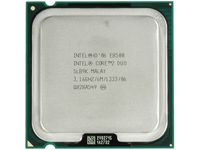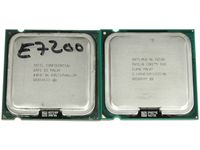How To: Get A 4 GHz Dual-Core For $120
Processor Alternatives
3 MB vs. 6 MB L2 Cache
The benchmark section will show that the Core 2 Duo E8500 is a good performer and that the Core 2 Duo E7200 at stock speed clearly lags behind. However, overclocking the E7200 with its 3 MB L2 cache quickly puts the entry-level Core 2 Duo in a favorable position. Clocked at 3.4 GHz, the Core 2 Duo E7200 outperforms the E8500 in almost all benchmarks except a few games and WinZip, which benefits from the E8500’s large L2 cache. Running at 3.8 GHz, the $120 Core 2 Duo E7200 is considerably faster than the E8500, which costs $210 or more.
The E8500’s 6 MB L2 cache clearly provides the higher performance needed for certain games, and the maximum memory performance for applications that require it. However, clock-speed increases lead to easier performance gains than more cache memory, as more applications scales better with increased clock speeds.
See our 2008 Desktop CPU Charts for more processor performance comparison.


There is another option for overclockers, too.
Pentium Dual Core
The Pentium Dual Core family was introduced after the Core 2 Duo, and unlike the Pentium 4 or Pentium D, the Pentium Dual Core has nothing in common with the good old Pentium processors. Instead, all CPUs named Pentium Dual Core are based on the same Core 2 cores, but use even less cache memory and run at slower system speeds. The Pentium Dual Core E2000 family uses only 1 MB shared L2 cache, and is available in 1.6 GHz to 2.4 GHz versions. The latest addition, model E5200, offers 2 MB shared L2 cache and it’s a 45 nm part, while all E2000 Pentium Dual Cores have been based on the 65 nm architecture.
Get Tom's Hardware's best news and in-depth reviews, straight to your inbox.
Because these budget processors cost even less than the Core 2 Duo E7200, they appear to be good overclocking options. And they are. In fact, they can typically be overclocked by up to 50 percent. Unfortunately, though, the performance level is considerably lower due to the budget processors’ limited L2 cache—typically 1 MB or 2 MB. What’s more, the 65 nm parts don’t include the performance enhancements offered by the 45 nm Core 2 generation.
Current page: Processor Alternatives
Prev Page Safe Overclock: 3.8 GHz (FSB1600) Next Page Test Setup and Benchmarks